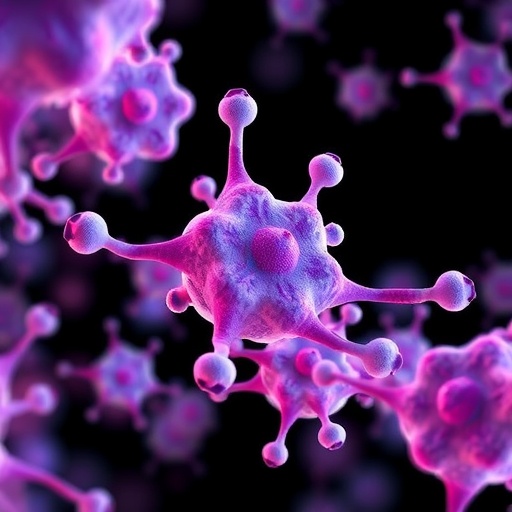In the relentless pursuit of forensic precision, determining the post-mortem interval (PMI)—the elapsed time since death—has consistently represented a formidable challenge. Conventional methodologies, often rooted in anatomical and environmental observations, present limitations in accuracy and reproducibility. However, a groundbreaking study published in the International Journal of Legal Medicine in 2025 ushers in a promising new frontier by exploring blood biochemistry as a potential biomarker for PMI estimation. This research, led by Grassi, Ciasca, Vetrugno, and colleagues, ventures into an intricate analysis of biochemical alterations post-mortem, heralding a transformative approach that could revolutionize forensic investigations globally.
At the heart of this preliminary case series lies a meticulous examination of blood samples from deceased subjects, analyzing the dynamic changes in biochemical parameters as death progresses. Unlike traditional methods that focus on physical changes such as rigor mortis or livor mortis, blood biochemistry offers a molecular window into the post-mortem process. The researchers leveraged advanced analytical techniques to quantify shifts in metabolites, enzymes, and electrolytes, mapping their trajectory against the timeline following death.
One of the significant insights from this study is the identification of specific blood components whose concentrations demonstrated a consistent, time-dependent pattern post-mortem. Among these biomarkers, electrolytes like potassium and enzymes such as lactate dehydrogenase showed marked fluctuations that correlate strongly with PMI. The increase in serum potassium concentration, for example, aligns with cellular breakdown and membrane permeability changes intrinsic to cellular autolysis after death. This biochemical cascade thus provides a measurable, quantifiable indicator that can be harnessed for time-since-death estimation.
.adsslot_ZEpFeGfsKm{ width:728px !important; height:90px !important; }
@media (max-width:1199px) { .adsslot_ZEpFeGfsKm{ width:468px !important; height:60px !important; } }
@media (max-width:767px) { .adsslot_ZEpFeGfsKm{ width:320px !important; height:50px !important; } }
ADVERTISEMENT
Furthermore, the investigators delved into metabolic waste products, noting that compounds such as hypoxanthine and ammonia display notable kinetic profiles in post-mortem blood. Hypoxanthine, a degradation product of ATP, accumulates as cellular energy stores deplete, marking the progression of tissue deterioration. Ammonia levels, meanwhile, rise due to proteolytic breakdown, offering another layer of biochemical context that could refine PMI calculations. The concurrent measurement of these metabolites, therefore, yields a multifaceted biochemical signature characteristic of the post-mortem timeline.
This study’s methodology also underscores the importance of controlling extrinsic variables that can potentially confound biochemical measurements after death. Factors such as ambient temperature, environmental humidity, and the deceased’s physiological state prior to death were given careful consideration. The researchers implemented standardized protocols for sample collection, storage, and processing to mitigate the influence of these confounders, thereby enhancing the reliability and validity of their data.
A notable technical advancement embraced by this research is the application of sophisticated statistical models and machine learning algorithms to interpret complex biochemical datasets. By integrating multiple biomarkers instead of relying on singular parameters, the study enhances predictive accuracy for PMI estimation. This multivariate approach recognizes the inherent biological variability and leverages computational power to discern subtle patterns, significantly reducing the margin of error compared to traditional forensic methods.
Beyond the intrinsic scientific merit, this investigation addresses a critical gap in forensic practice. The conventional techniques for estimating PMI are largely subjective and often imprecise, especially in cases where environmental conditions accelerate or retard decomposition unpredictably. Blood biochemistry presents an objective, reproducible metric that, if validated with larger cohorts, could become a forensic gold standard. This transition from subjective observation to empirical measurement promises to elevate the evidentiary value of PMI determinations within legal frameworks.
However, the study also candidly acknowledges limitations inherent to a preliminary case series. The relatively small sample size restricts generalizability, necessitating expansive multi-center trials to substantiate the findings. Moreover, variables such as diverse causes of death, comorbid conditions, and pre-mortem pharmacological influences require comprehensive evaluation to delineate their potential impact on post-mortem biochemical changes.
The implications of this research extend beyond forensic pathology into broader biomedical fields. Understanding post-mortem biochemical kinetics enriches our comprehension of cellular decay mechanisms and could inform organ transplantation protocols and post-mortem tissue preservation strategies. Furthermore, elucidating these molecular signatures may pave the way for developing rapid, bedside diagnostic tools in forensic settings, accelerating timely decision-making during investigations.
Intriguingly, the study underscores the necessity of interdisciplinary collaboration, blending forensic science, biochemistry, computational analytics, and clinical expertise. This synergy catalyzes innovation, fostering methodological rigor and technological sophistication essential for translating laboratory insights into practical forensic applications. It exemplifies the evolution of forensic science into a data-driven, precision discipline grounded in molecular biology.
As the authors anticipate, future research trajectories are poised to incorporate high-throughput omics technologies—proteomics, metabolomics, and transcriptomics—to capture a comprehensive molecular portrait of the post-mortem interval. Such holistic profiling will likely unearth novel biomarkers and intricate networks governing post-mortem biochemical dynamics. Coupled with artificial intelligence-enhanced predictive analytics, these endeavors hold promise for unprecedented specificity and sensitivity in PMI estimation.
Moreover, the potential for real-world implementation is tangible. Portable biochemical analyzers designed for rapid on-site assessment could transform crime scene investigations, enabling forensic experts to derive immediate and accurate PMI estimates. This capacity would dramatically expedite investigative timelines and strengthen the evidentiary chain, thereby enhancing judicial outcomes.
In conclusion, the pioneering study by Grassi and colleagues marks a significant leap in forensic science, illuminating the latent potential of blood biochemistry as an objective marker for determining time since death. While preliminary, the compelling evidence sets a foundation for future expansive research aiming to refine and validate this approach. This innovative paradigm underscores a shift towards molecular forensics, promising to override the limitations of traditional methods with precision, reliability, and scientific robustness that legal medicine desperately needs.
As forensic challenges diversify with increasing complexity, integrating biochemical insights into PMI determination represents a critical evolution. This research not only enriches the scientific arsenal but also resonates with societal imperatives for justice, transparency, and accuracy in death investigations. The transformative impact envisioned by this study heralds a new era where the secrets held within the molecular remnants of life can reveal time’s passage beyond doubt, redefining forensic timelines for generations to come.
Subject of Research: Post-mortem interval estimation through blood biochemistry
Article Title: Exploring the post-mortem interval through blood biochemistry: a preliminary case series study and review of the literature
Article References:
Grassi, V.M., Ciasca, G., Vetrugno, G. et al. Exploring the post-mortem interval through blood biochemistry: a preliminary case series study and review of the literature. Int J Legal Med (2025). https://doi.org/10.1007/s00414-025-03576-1
Image Credits: AI Generated
Tags: accuracy in PMI determinationadvances in forensic sciencebiochemical changes after deathblood biochemistry in forensicsdeath investigation methodologieselectrolytes as forensic indicatorsforensic biomarkers for deathInternational Journal of Legal Medicine findingsmolecular insights into post-mortem processespost-mortem analysis techniquespost-mortem interval estimationtransformative research in legal medicine





